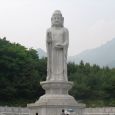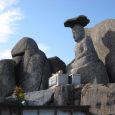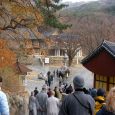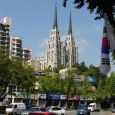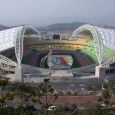Daegu
Advertisement
By Air
Daegu is served by Daegu Airport (international/domestic) located in northeastern Daegu.
By Train
Daegu is the hub of the Korean inland railroad traffic.The main railroad of the country, Gyeongbu Line passes through the city.The largest railroad station in the city, Dongdaegu Station has the second largest passenger traffic in Korea after Seoul Station and the largest train traffic.The station re-opened in 2004 after extensive renovations serves the KTX highspeed train, Saemaul and Mugunghwa trains.All kinds of trains except KTX depart from Daegu Station, an all-new building with cinemas, restaurants and a department store, located near the city centre.It has the tenth largest passenger traffic in Korea.Daegu Line branches off from Gacheon Station of Gyeongbu Line.
By Metro
The city also has a subway system, consisting of two heavy rail lines. Line 1 crosses the city from northeast to southwest, while Line 2 crosses from west to east. Line 3 from northwest to southeast is under construction as an elevated monorail. All the lines are and will be operated by the Daegu Metropolitan Transit Corporation (DTRO). Another line will operate in a few years as a heavy rail system using the Gumi–Daegu–Gyeongsan section of Gyeongbu Line. Line 4 is a long-range plan and will be a circle line. Fare is 1100 won on distance and 950 won with a prepaid card. There is a free interchange scheme between the metro and bus within an hour of first use for the prepaid card users.
By Road
There are two types of buses which are local and limited express.Limited express buses have more seats, but often passengers are required to stand. As of 2008, Local bus fare costs around 1100 won, Limited express bus fare would set you back around 1500 won. Discounted fare is available with a prepaid card.Bus route numbers are made up with 3 digits, each number indicates the area that bus serves. For example, number 407 bus runs from zone four, to zone zero, and then to zone seven. Other routes, usually circular, are named for the districts they serve and numbered 1 through 3.Traffic is sometimes heavy, however, the major thoroughfares handle fairly high volumes of traffic without too much trouble.
Daegu Opera House
which is shaped like a grand piano, is a venue capable of accommodating 1,500 people on its 4 floors and 2 basements. The building has been designed with the satisfaction of the audience in mind, that is, in a manner that effectively utilizes the venue's high quality acoustic facilities and virtual space, thus leaving the audience free to enjoy a unique musical experience.The exterior of the building is made of glass, which makes it possible for passersby to peer inside the lobby. Especially impressive is the building's illumination system, which is arrayed in a manner that attracts people from afar; and the lobby, which without being over-elegantly decorated, strikes visitors with its refined atmosphere.The Daegu Opera House, situated in the heart of the city, has become one of the city's landmarks by providing artists with a stage on which to display their work and audiences with easy access to high-quality performances.The Daegu Opera House is expected to become one of Korea's remiere performance hubs.
World Bodypainting Festival
is an annual festival. From 1998 to 2010 the Festival was held in Seeboden, Carinthia, Austria, near the Millstatter See, on the third week of July every year.The new venue is Portschach at lake Worthersee.The festival lasts a week of which the first four days consist of over thirty special workshops and lessons run by the WBF Academy and the last three days consist of the actual festival event in the body paint city which is open to the public without prior reservation.The festival event is open for both adults and children, and many families come there together.The artists compete in many categories: brush and sponge, airbrush and special effects are World Champion titles. At night time there is also a special UV effects contest giving the title for World Champion in UV bodypainting effects. There is a World Facepainting Award and a special award for special effects face make up.There are also semi professional student awards. All categories have separate prizes and trophies.Artists can use either male or female models as they wish.All models must be wearing underpants while painted, but female models can go topless if they want.Many body painting models are unpaid and volunteer for the unique experience of transformation by the body painting artists.
Daegu National Museum
is a national museum located in Hwanggeum-dong, Suseong-gu, Daegu, South Korea. It opened on December 7, 1994 and holds approximately 30,000 artifacts. Its main collection consists of archaeological objects from daegu and Gyeongsangbuk-do region.
Daegu Bangjja Yugi Museum
is Korea's first bronzeware-specialized museum built to preserve the Bangjja Yugi, a traditional cultural property.It also aims to hand down its manufacturing technology to posterity so that the excellence of traditional Korean cultural assets may continue to be presented, and the development of local culture will be promoted.The Museum houses 1,489 items of Yugi in 275 types donated without compensation by Mr. LEE Bong-ju, who made and collected Yugi.Artisan LEE Bong-ju was designated by the central government in 1983 as the Important Intangible Cultural Asset No. 77.It is rare to find countries in the world that preserve Yugi manufacturing technology.Under these circumstances, the Daegu Bangjja Yugi Museum will do its best in building diverse cultural contents with IT and CT integrated in order to meet the age of cultural competition in the 21st century.This will help to attract the attention of new generations, and motivate them to foster cultural infrastructures unique to this area.
Donghwa Temple
is a Buddhist temple of the Jogye Order in northern Daegu, South Korea.The temple is located on the slopes of Palgongsan, within the boundaries of Dohak-dong, Dong-gu, near Daegu's northern border.It is the seat of the 9th region of the Jogye Order.The name means "temple of paulownia blossoms."The first temple on the site was built in 493.The name Donghwasa was applied during the Unified Silla period in 832.From this time to the present it has remained one of the country's most powerful temples.During the Goryeo Dynasty it was one of only four temples which administered the civil service examinations for monks.Buddhists were out of power during the Joseon Dynasty but the temple retained a great deal of influence and continued building new structures.Several National treasures of South Korea are housed at Donghwasa.
Gatbawi
is a Buddhist statue in Daehan-ri, Wachon-myeon, Gyeongsan, Gyeongsangbuk-do, the Republic of Korea.It was made in the Unified Silla Kingdom era and is well known with the name of Gatbawi Buddha (Stone Hat Buddha).It sits 4m tall and the hat is a 15cm thick flat stone on his head.This single granite sculpture was made up by Uihyeon, at the top of the 850 meters high rough Palgongsan and is surrounded by a screen-like rockwall as its background.It is said that Uihyeon made it in order to appease his mother's soul in the 7th ruling year of Queen Seondeok of Silla Kingdom.The legend says that a big crane flew in to guard him every night while he was making this Gatbawi Buddha.It is reputed to be a miraculous Buddha stone, which makes a response to prayers if the prayer prays for it with his or her whole heart.
Apsan Park
is a large wilderness park located in the south of Daegu, South Korea. It covers a series of valleys and peaks of Apsan mountain.Inside the park is a museum dedicated to the Korean War, the Nakdong River Battle Museum. The museum also contains an anti-communism hall. Nearby is a small amusement park and restaurants. A gondolla leads to one of the peaks, and a series of trails also lead to the various peaks.Ansil-sa and a couple of other Buddhist temples are located within the park.The area of Apsan park is 1,653 m2.
Nakdong River Battle Museum
is a small museum built inside the Apsan Park to commemorate the soldiers and civilians killed during the Korean War at a battle that raged near the Nakdong River.The grounds around the museum are scattered with vintage tanks and airplanes from the Korean War. Built in 1979 the museum has two floors with exhibits from the Korean War and other significant eras in Korea's past. Other areas within the museum pay tribute to those that died in both natural and man-made disasters in Korea's past.
October - February
April - August


